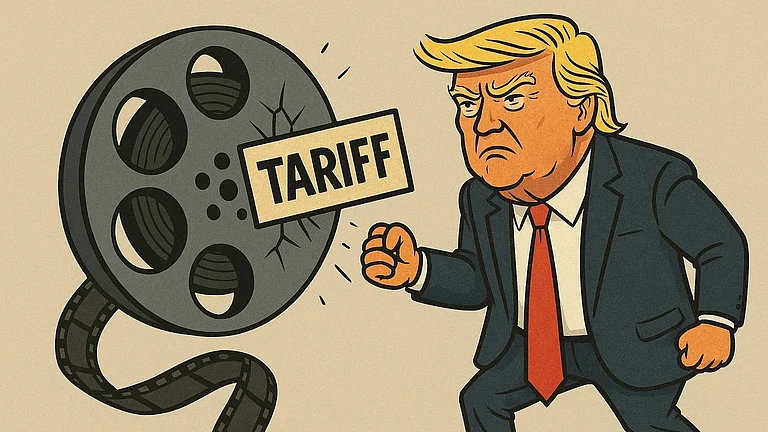After she retired in 2019, Kanpur’s Mita Chakravorty, a former school principal, did not have much to keep her occupied. The pandemic and the ensuing lockdowns made things worse. That is when 64-year-old Chakravorty ventured into the digital space, going beyond the occasional social media surf and WhatsApp messages. The time when even withdrawing cash had became a problem was when she started pushing herself to switch to net banking. The initial help came from her children who would also connect with her online as they are settled abroad. Then came a string of necessary apps.
Today, the sexagenarian does everything online—from her entire grocery shopping to paying all her utility bills and shopping from online beauty retailer Nykaa. She even learns yoga virtually and surprised her friends by taking an online session on mental wellbeing during the lockdown. But her favourite digital moment? Successfully joining the Facebook live sessions held by Rangmilap, a Kolkata-based saree store.
Chakravorty represents swathes of women consumers who are going online with gusto. Data, too, reflects the rise of the new woman digital consumer. A 2020 survey by YouGov revealed that around 72% of its 1,014 respondents access the internet for online shopping with many using it to stream videos (58%), watch news (58%) and stream music (57%) and for online banking (57%). For instance, two in five women, or about 37%, cannot function without the internet for more than a few hours and 30% said they could not function without it beyond an hour. Interestingly, women are also entering spaces commonly designated as men’s bastions. Two in five women spent time on the internet for gaming and one in eight used it for online dating, the survey concluded.

Surfing in Uncharted Waters
Author Vijetha S.N. has always been very particular about skin-care brands and their quality. When she lived in Bengaluru, she often shopped at high-end stores in malls. That changed when she moved to Somwarpet in Coorg. “It was then that I started exploring online and discovered Nykaa,” says Vijetha. Today, she is one of Nykaa’s loyal customers.
The platform also witnessed an unprecedented increase in its visitor count during the pandemic. It currently has over 15 million registered users and dispatches around 1.5 million orders every month.
A 2018 study conducted by Nielsen and the Boston Consulting Group, titled Digital Consumer Spending in India: A $100B Opportunity, had predicted that there would be 2.5 times more women shoppers by 2020 as compared to that year—a trend that was further accelerated by the pandemic.
E-commerce giant Amazon also saw the number of women shoppers on its platform jump 1.5 times in 2021 as compared to the previous year in India. This spike was led mainly by demand in the fashion and beauty categories. According to Amazon, remote working and online engagements drove the need for lounge wear, comfort wear and waist-up fashion. Overall, 45% of its customers from the beauty and fashion segment belong to the 25-35 age group and 20% fall in the 18-20 bracket.

This trend is not just limited to make-up, jewellery and apparel. Dating has emerged as one area for which women are increasingly using the digital mode. The pandemic saw more women flock to these apps than ever before. In an interview to CNN last year, Bumble CEO Whitney Wolfe Herd said that the dating app, which interestingly allows only women to make the first move, saw five million first moves made by women. In India, Bumble has a dedicated following among urban women. “Seventy-two per cent single Indians surveyed think it is possible to fall in love online with someone they have never met in-person. Forty-five per cent believe virtual or online dating is the normal way of dating in India. People are finding virtual dates to be a safer way to engage,” says Samarpita Samaddar, India communications director, Bumble. With the pandemic forcing people indoors, women also explored home chores online, a trend that seems to have continued. Urban Company, an online home services platform, currently serves three million women through its salon service and has witnessed a steady increase in its customer base. “Our salon vertical has seen a y-o-y growth of 110% on an average,” says Smit Shukla, vice president, marketing, beauty and personal care, Urban Company.
Women are also asserting themselves by taking control of their finances through sites like LXME, a financial planning platform for women launched in 2021. “Delving into preparatory research for LXME, we realised that a lot of women shy away from asking questions because most of these platforms were dominated by men. There is a fear of being judged. Also, it is not very easy for advisors to reach out to people in smaller cities. LXME fixes these gaps,” says Priti Rathi Gupta, managing director and promoter, LXME. The app currently has 60,000 registered users across India, most of them in the 25-40 age bracket.

Digital Means Opportunities
Women are realising their dreams in the digital universe, sometimes even by pursuing alternate careers from the comfort of their homes. SHEROES, a women-only social platform founded by Sairee Chahal in 2013, is one platform that offers resources, mentorship, network and career opportunities to women online. Today, close to 24 million women are part of it as micro-entrepreneurs, artists, homemakers, online resellers, gig workers, nutritionists, counsellors, coaches, and more. About 70% of them belong to towns and come from outside the usual Tier I cities. The age group that it covers is vast—from 13 to 70 with the 18-to-28 bracket witnessing the fastest growth.
“We see more women looking for connection, seeking a safe space for expression and wanting to build a financial and social identity. They are also looking to access opportunities—from building skills and launching their online businesses and stores to accessing credit, mentorship and a peer network,” says Chahal. During the pandemic, around six million women joined the platform.
This has left investors curious. Mekin Maheshwari, founder of Udhyam Learning Foundation and co-founder of Global Alliance for Mass Entrepreneurship, is currently one of the investors in SHEROES. “The SHEROES business model offers a triple bottom line of people, planet and profits in focus. I am excited to be part of that journey because the platform drives scalable access to employment, entrepreneurship and capital for India’s women,” he explains.
Even big names are jumping on this women-led bandwagon. Chairman of the Mahindra Group, Anand Mahindra, for instance, has invested in Shethepeople.tv, a digital platform for women’s stories on leadership, entertainment, politics, business and science. The platform, which has engaged with 85 million women through its content so far, also doles out career advice, creates a discourse around women’s health, sexuality and encourages networking.
Digital also means free access and endless opportunities for independent women sellers as well as buyers. Pune-based Sayalee Marathe set up a silver jewellery brand, Aadyaa Originals and ships jewellery to women customers across India. Some of her orders even come from areas where there are no courier services. “I have a client who lives 35 kilometres away from the main post office in Tehri Garhwal in Uttarakhand. I send her orders via speed post and she collects them from the post office. I have several such clients,” says Marathe. Aadyaa has 50,000 registered women customers on its website and the company ships 1,500-2,000 orders every month.
Of Reskill, Upskill and More
An accident in 2011 had forced Umaa Subbramanian, a Chennai-based IT professional, to take an eight-year career break. “I started helping my husband out in his family business, but I always wanted to get back to technology,’’ says 55-year-old Subbramanian.
Opportunity came knocking at her door when she was hired by an MNC, a breakthrough that, she says, was made possible because of VMInclusion Taara, an initiative by California-based software firm VMware. The initiative offers free certification courses on digital transformation technologies and has seen a jump in enrollment from 639 in 2018 to 7,056 in 2021.
According to Coursera’s Women and Skills Report 2021, with 4.8 million registered women learners, India ranks second in the world when it comes to women seeking online learning. The US leads the pack with 8.6 million. The study revealed that the median age of women online learners was 27 with computer programming, machine learning and probability and statistics emerging as the top three areas of interest.
Mayank Kumar, co-founder and managing director of upGrad, confirms the upward trend of women learners on virtual platforms. “Evolving job specifications and industry dynamism are encouraging women professionals to proactively upskill themselves, particularly in technical and soft skills, a trend also observed in upGrad,” he says. In 2021, the edtech firm registered a 600% rise in women learners at an enrollment level since 2019. Around 40% of its women learners are in the three to five years’ work-experience bracket.
Social Media on Driver’s Seat
While the government wants to push digital inclusion through its Digital India initiative, what is really driving this trend is the wide-spread adoption of social media by women. “The adoption of social networking platforms such as Facebook and Instagram by women across age groups adds an additional contribution of social influencing and marketing-driven adoption of products and services. Increasing category and brand awareness, shopping convenience and the benefits of browsing products in the home environment have benefited the woman shopper,” says Angshuman Bhattacharya, national leader, consumer product and retail sector, EY India.
As per EY, over the next five years as internet shopping penetrates deeper into Tier II and Tier III markets and eventually rural India, the number of online women shoppers is expected to keep growing at 20% which is ahead of the overall online shoppers.
However, Madhu Singh Sirohi, head of policy programs and outreach, Facebook India, believes that there is a lot that still needs to be achieved. “With more than 800 million internet users in the country, only 33% are women. This gap needs to be bridged. At Meta, we are making efforts to bring gender parity to the internet by not only giving access to more women but also giving growth opportunities and platforms to women entrepreneurs and women-led businesses,” says Sirohi.


























